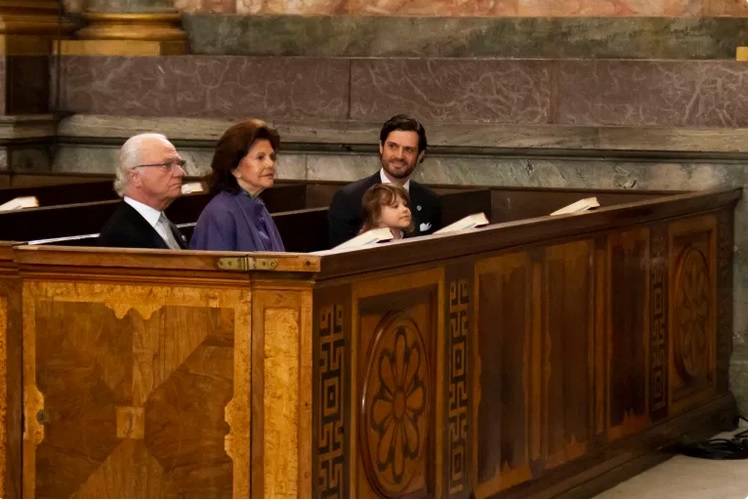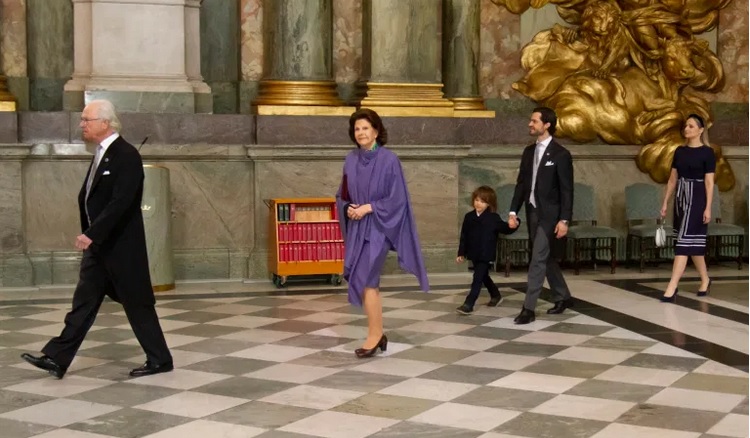NordenBladet – Members of the Swedish Royal Family attended a Te Deum* at the Royal Chapel in Stockholm Palace on Sunday at noon to mark the birth of Prince Julian.
Due to the pandemic, those in attendance were limited to King Carl XVI Gustaf, Queen Silvia, Prince Carl Philip, proud big brother Prince Alexander, Princess Sofia’s sister, Lina, and Sofia’s parents, Erik and Marie Hellqvist. Sofia’s parents were able to travel from Älvdalen to meet their new grandson and attend the ceremony.
Crown Princess Victoria and Prince Daniel of Sweden just recently recovered from COVID-19 and were unable to attend the service. They had planned to attend before contracting the virus; the couple are now healthy but followed doctor recommendations to not participate on Sunday, according to Svenskdam.
The media was not allowed to attend the religious service due to the pandemic, and images were only released after the Te Deum had concluded.
Lead pastor Johan Dalman lead the service that began at noon; a small lunch followed, but the Royal Court has not released any information regarding the gathering.
The christening for Prince Julian will take place in a few months time. How the pandemic will impact the ceremony is not yet known.

___________________________
The “Te Deum” (/tiː ˈdiːəm/, Latin: [te ˈde.um]; from its incipit, Te Deum laudamus, Latin for ‘Thee, O God, we praise’) is a Latin Christian hymn traditionally ascribed to AD 387 authorship, but with antecedents that place it much earlier. It is central to the Ambrosian hymnal, which spread throughout the Latin Church with other parts of the Milanese Rite in the 6th to 8th centuries. It is sometimes known as the “Ambrosian Hymn”, although authorship by Saint Ambrose is unlikely. The term “Te Deum” can also refer to a short religious service (of blessing or thanks) based upon the hymn.
Authorship of the hymn is traditionally ascribed to Saint Ambrose (died 397) or Saint Augustine (died 430). In 19th-century scholarship, Saint Hilary of Poitiers (died 367) and Saint Nicetas of Remesiana (died 414) were proposed as possible authors. In the 20th century, the association with Nicetas has been deprecated, so that the hymn, while almost certainly dating to the 4th century, is considered as being of uncertain authorship. Authorship of Nicetas of Remesiana was suggested by the association of the name “Nicetas” with the hymn in manuscripts from the 10th century onward, and was particularly defended in the 1890s by Germain Morin. Hymnologists of the 20th century, especially Ernst Kähler (1958), have shown the association with “Nicetas” to be spurious. It has structural similarities with a eucharistic prayer and it has been proposed that it was originally composed as part of one.
The hymn was part of the Old Hymnal since it was introduced to the Benedictine order in the 6th century, and it was preserved in the Frankish Hymnal of the 8th century. It was, however, removed from the New Hymnal which became prevalent in the 10th century. It was restored in the 12th century in hymnals that attempted to restore the praiseful intent of the rule of St. Benedict.
In the traditional office, the “Te Deum” is sung at the end of Matins on all days when the Gloria is said at Mass; those days are all Sundays outside Advent, Septuagesima, Lent, and Passiontide; on all feasts (except the Triduum) and on all ferias during Eastertide.
Before the 1961 reforms of Pope John XXIII, neither the Gloria nor the Te Deum were said on the feast of the Holy Innocents, unless it fell on Sunday, as they were martyred before the death of Christ and therefore could not immediately attain the beatific vision.
In the Liturgy of the Hours of Pope Paul VI, the “Te Deum” is sung at the end of the Office of Readings on all Sundays except those of Lent, on all solemnities, on the octaves of Easter and Christmas, and on all feasts. A plenary indulgence is granted, under the usual conditions, to those who recite it in public on New Year’s Eve.
It is also used together with the standard canticles in Morning Prayer as prescribed in the Anglican Book of Common Prayer, as an option in Morning Prayer or Matins for Lutherans, and is retained by many churches of the Reformed tradition.
The hymn is in regular use in the Catholic Church, Lutheran Church, Anglican Church and Methodist Church (mostly before the Homily) in the Office of Readings found in the Liturgy of the Hours, and in thanksgiving to God for a special blessing such as the election of a pope, the consecration of a bishop, the canonization of a saint, a religious profession, the publication of a treaty of peace, a royal coronation, etc. It is sung either after Mass or the Divine Office or as a separate religious ceremony. The hymn also remains in use in the Anglican Communion and some Lutheran Churches in similar settings.
Photos: Henrik Garlöv /The Royal Court of Sweden
